Contents
- 1 What is the Printed Circuit Board Assembly?
- 2 Preparation Before PCB Assembly
- 2.1 2.1 PCB design basis
- 2.2 2.2 PCB assembly requires electronic parts and consumables
- 2.3 2.3 The three main types of PCBs
- 2.4 2.4Three installation technologies in the PCB assembly industry
- 2.5 2.5 DFM Inspection
- 2.6 What is DFM inspection?
- 2.7 Why do we need to conduct a DFM inspection?
- 2.8 Importance
- 3 How to Carry out the Detailed Steps of the PCB Assembly
- 4 13 Effective Test Methods for Printed Circuit Board Assembly
- 4.1 4.1 Why We Do A PCBA Test
- 4.2 Bare Board Test
- 4.3 Assembly Level Test
- 4.4 Online Test
- 4.5 On –line testing of FICT Without Fixtures
- 4.6 Functional Circuit Test
- 4.7 Boundary Scan Test
- 4.8 JTAG Test
- 4.9 X-ray Fluorescence Transmission
- 4.10 X-ray lamination system
- 4.11 Ion Contamination Test
- 4.12 Chemical Resistance Test of Solder Mask
- 4.13 Hardness Test of Solder Mask
- 5 The Difference Between PCB Assembly, THT Assembly, SMT Assembly, and Hybrid Technology
- 6 PCB Assembly Process-welding
- 7 PCB Assembly
- 8 Prepare Printed Circuit Board Assembly Documents.
- 9 Common Problems of the Printed Circuit Board Assembly
- 9.1 1. Problems that should be paid attention to between traditional PCB assembly and modern PCB assembly
- 9.2 2. LED problems during PCB assembly
- 9.3 3. Too small/too large copper edges
- 9.4 4. Solder joint defects
- 9.5 5. PCB assembly of small parts
- 9.6 6. Problems with the dispensing method
- 9.7 7. Assembly of regular and irregular patches
- 9.8 8. Material adhesion problems during PCB assembly
- 9.9 9. The PCB assembly process solves the heat dissipation problem
- 9.10 10. Design for Manufacturing (DFM)
- 10 PCB Assembly Service
- 11 Summary
What is the Printed Circuit Board Assembly?
Also known as PCBA, printed circuit board assembly may be a very complicated concept to comprehend. But why, you may ask.
The reason is that PCBA isn’t the same as printed circuit manufacturing, also referred to as PCB. Printed circuit board assembly and PCB manufacturing have different requirements and standards.
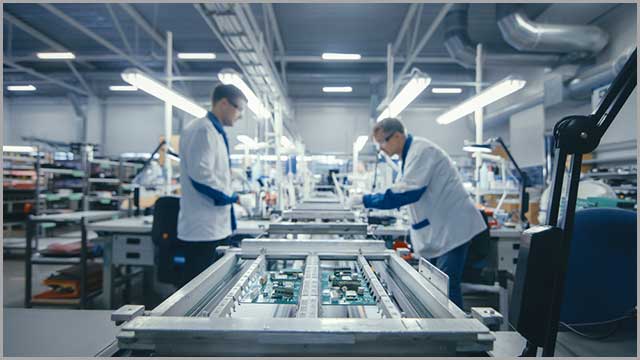
Preparation Before PCB Assembly
2.1 PCB design basis
Substrate—A PCB substrate is a solid material that holds its components and traces. Before PCB assembly, you must ensure you use the right substrate material.
Selecting the right substrate is the first step towards having the best PCB. In short, the right substrate materials mostly affect the performance of your PCB.
Copper is one of the most common elements used in making traces. But why is copper a trendy choice across the printed circuit board industry?
Copper’s most significant benefit is its high conductivity. Copper can properly transmit signals without losing electricity.
Solder mask—A solder mask is a layer found on top of the copper foil. This layer gives a printed circuit board its green color.
The solder mask is overlaid onto the copper layer to insulate copper traces and protect copper traces of a PCB against cases of oxidation.
The solder mask also prevents solder bridges from forming between closely spaced pads.
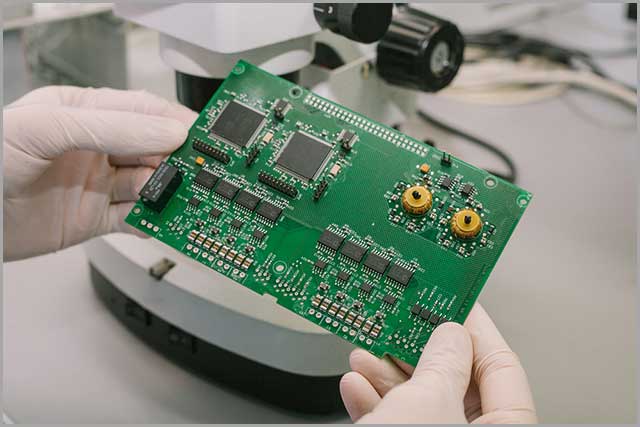
2.2 PCB assembly requires electronic parts and consumables
Printed circuit board
The Electronics Components
Soldering flue
Soldering equipment
(wave soldering machine, station, SMT equipment, inspection, and testing equipment).
2.3 The three main types of PCBs
Printed circuit boards are classified based on frequency, the substrate used, and the rate. Some of the most popular ones include the following:
• Rigid PCB—Rigid PCBs are printed circuit boards fabricated from robust materials that can’t be bent. They are compact and very easy to repair in the event of damage.
If you are in the market for a PCB that is easy to maintain, you better go with rigid PCBs.
• Metalcore PCB: (FR4 board)—FR4 PCBs are finding use in many electronic equipment lately. FR indicates that the material is flame retardant, while 4 shows the four elements used in the production of these types of PCBs.
2.4Three installation technologies in the PCB assembly industry
• Surface mount technology—This is a method of mounting electrical components directly on the surface of a printed circuit board (PCB). The electrical components installed in this way are surface-mount devices (SMD).
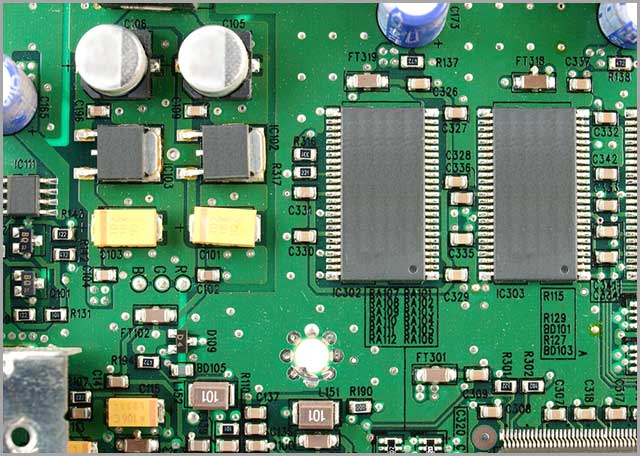
• Through-hole technology – This is a mounting scheme used in electronic components involving leads on parts inserted into the holes drilled in the printed circuit board and soldered to pads on the opposite side of the committee manually or automatically.
• Hybrid technology—Hybrid technology is another accessible installation technology that uses dissimilar materials to optimize electrical performance and improve system reliability.
2.5 DFM Inspection
What is DFM inspection?
Also known as DFM, Design for Manufacturing involves designing parts, products, or components for ease of manufacturing to produce the end product at a lower cost.
DFM inspection is checking a printed circuit board for its functionality. DFM inspection involves a review of the bill of materials, parts not recommended for manufacturing, and components that require immediate replacement.
Why do we need to conduct a DFM inspection?
DFM inspection has plenty of benefits. It allows designers to understand a product’s reproducibility and repeatability.
It also guides on tolerances during the manufacturing process and whether the demands of the product are reasonable.
Some of the issues covered during DFI include checking how tolerance issues will impact the gauging system and detecting matters concerning non-conformances.
Importance
As mentioned earlier, design for manufacturing is the process of designing products to make them easy to manufacture.
DFM is one of the most critical manufacturing tooling process development and tooling design steps before building a new product.
DFM is essential when planning to design a new product. It is also necessary when manufacturing PCBs because it can ensure product production.
With DFM, products won’t quickly go back to the drawing board. DFM can affect your product’s feel, look, function, and precision. Lastly, it can significantly affect your timelines.
How to Carry out the Detailed Steps of the PCB Assembly
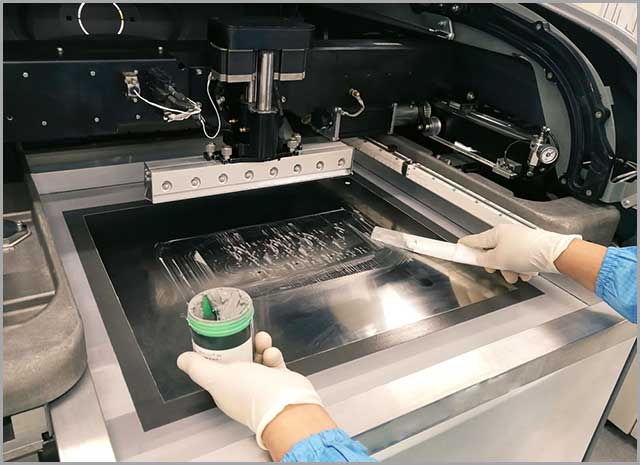
Second Step: Pick & Place
After the application of the solder paste, the PCB Rapid Prototyping. 3D PCB Printing not only makes the PCB but it also does the Printed Circuit Board Assembly (PCBA process moves to the pick and place machine. Initially, pick, and the place was a manual method whereby you had to use a pair of tweezers to assemble all the elements of a PCB by hand. However, with improved technology, wne now have robots automated to pick and place parts of a PCB. The robot also positions the PCB appropriately and applies surface mounts to the surface of the PCB.
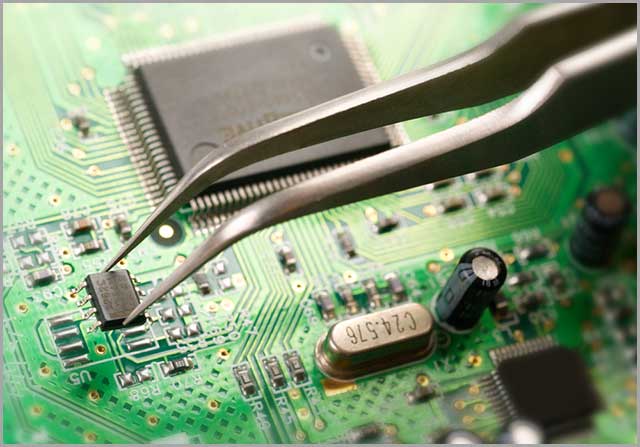
Third Step: Reflow Soldering
When the PCB elements and the solder paste are in place, they must adhere correctly. For this reason, the dough has to solidify to attach parts to the board through reflow.
A majority of PCBAs need special consideration in the reflow process, more so for two-sided printed circuit board assembly.
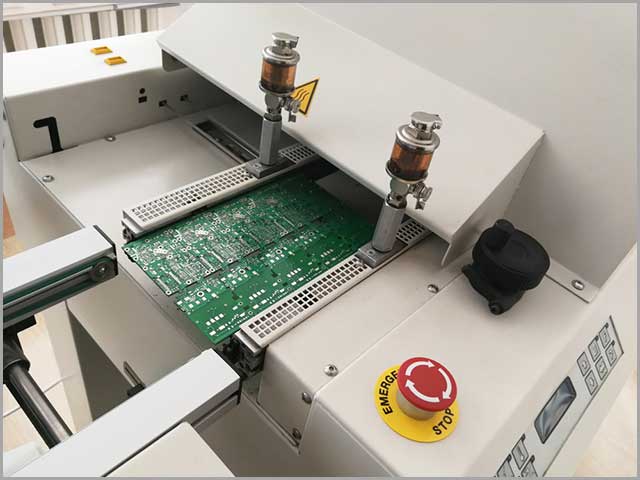
Fourth Step: Inspection & Quality Control
Unfortunately, manual assembly tends to be inaccurate. Automatic Optical Inspection is more appropriate and ideal for large batches.
Here, PCB manufacturers use automated machines to process high-quantity PCBs quickly.
Lastly, there’s an X-ray inspection. This method is not common, though it is heavily used in complex and layered PCBs.
With X-rays, a viewer can see through layers and visualize the lower layers to see hidden problems.
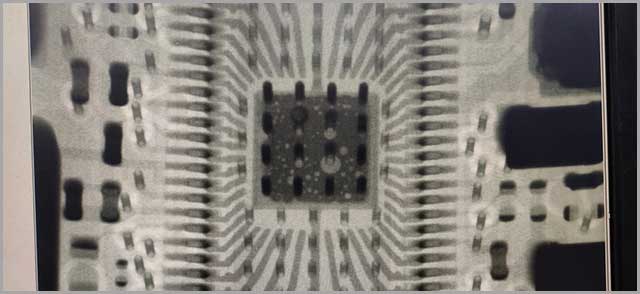
Fifth Step: Through-hole assembly
Depending on the circuit board under construction, it could bear various elements that are not usually on surface-mount devices.
They may include plated thru-hole details or PHT. In addition to soldering paste, PHT components may require specialized soldering methods such as manual soldering or wave soldering. Manual soldering isn’t a complicated process.
An individual inserts elements into a designated PTH before transferring them to the next station. Manual soldering can be lengthy, with many companies trying to avoid using it.
Wave soldering is another PTH insertion method. Most people might call it the automated version of manual soldering, but it is a different process.

13 Effective Test Methods for Printed Circuit Board Assembly
If you are thinking about PCBA, you need to be aware of PCB failure’s high costs. The last thing on your wishlist is seeing your PCB dropping dead without warning. Here are 13 effective test methods for PCBA:
4.1 Why We Do A PCBA Test
Bare Board Test
A bare board test involves testing the continuity and isolation of electronic connections on a bare/empty printed circuit board. This test is on the blank board before attaching essential parts such as ICs.
Assembly Level Test
Assembly-level tests are essential for checking a PCB’s functionality. These types of tests are completed manually or using automated test equipment. Mechanical test equipment tends to be expensive, though the results are excellent.
Online Test
Also referred to as automated tests for PCBs, online checks can be undertaken after the manufacturing process of a PCB is complete. With online tests, PCBs are inspected thoroughly using a flying probe or adapter E-Test equipment.
On –line testing of FICT Without Fixtures
Another name for a Fixtureless in-circuit test (FICT) is the flying probe test. It works without a custom fixture, thereby minimizing the overall costs of inspections.
FICT uses a simple installation that holds the board as the test pins move and test relevant points on the PCB.
Functional Circuit Test
This test is the final gatekeeper in the printed circuit board manufacturing plant. Functional circuit tests provide either a no-go or go choice on finished PCBs.
Functional circuit tests check for the overall product. It is an analysis aimed at determining whether everything works correctly.
Boundary Scan Test
We consider boundary-scan test checks for PCB wire lines as a preferred means of testing PCBs, especially when it’s hard to reach the entire nodes of the PCB.
Something good about this test is that it can quickly assess the whole board without needing to touch or reach all its nodes.
JTAG Test
Also known as the Joint Test Action Group test, is another crucial test for the manufacture of PCBs.
The is necessary to verify designs in addition to testing PCBs after completing the manufacturing of a PCB. JTAG tests are cost-effective and strengthen the overall quality of the finished PCBs.
X-ray Fluorescence Transmission
This test is a test whose purpose is to view the internal construction of a PCB, including layers and vias. This test is also essential in verifying the authenticity of a PCB. With such tests, manufacturers can find and locate defects during the early manufacture of PCBs. Of importance to note is that such tests need to be conducted by highly trained experts.
X-ray lamination system
This type of test is closely related to X-ray fluorescence transmission, which works by generating a focal plane. The focal plane is created through scanning, where an X-ray detector spins synchronously.
This type of test identifies errors such as missing solder joints, misalignments, and inadequate wetting.
Ion Contamination Test
Close to 25% of PCB failure takes place due to ionic contamination. Also known as the resistivity of the solvent extract (ROSE) test, ionic contamination tests detect ionic tissues that remain behind after soldering.
Chemical Resistance Test of Solder Mask
This type of test mainly aims to identify a solder mask’s chemical resistance.
This type of analysis is not as complicated as such. However, when done wrongly, The result may not be the same as expected.
Hardness Test of Solder Mask
This type of test aims at examining the hardness of a PCB’s solder mask.
Just as the name suggests, this type of analysis checks the hardness of a PCB to determine whether it can function as intended.
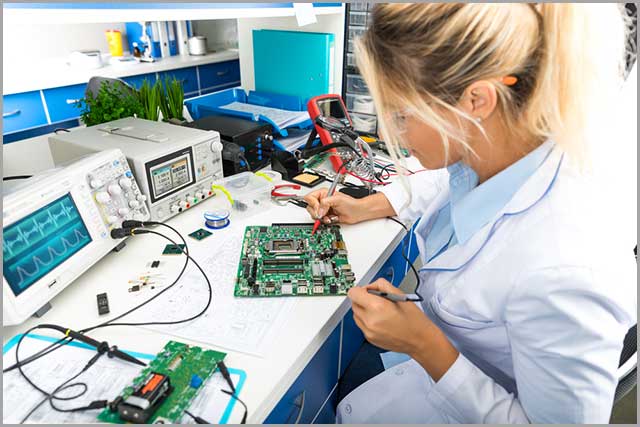
The Difference Between PCB Assembly, THT Assembly, SMT Assembly, and Hybrid Technology
5.1 Through-hole technology (THT) assembly process
Through-hole technology inserts components with leads and tails into holes requiring drilling in the PCB. These boards are known as through-board components. These leads can then be soldered onto lands or pads on the board’s underside, mostly through a wave solder process. The following is the THT assembly process:
Step 1: Component placement
Component placement is an electronics manufacturing process involving the installation of electronic components on a printed circuit board to create electrical interconnections between functional components and the interconnecting circuitry in the PCB.
Step 2: Check and correct
Checking and correcting is the second step in THT.
It involves checking and correcting any errors on a printed circuit board. Checking aims to find mistakes and fix them before a PCB is ready for the market.
Step 3: Wave soldering
Wave soldering is a large-scale soldering process in which electronic components are soldered to a PCB to create an electronic assembly.
The name derives from the use of waves of molten solder to attach the metal components to the printed circuit board.
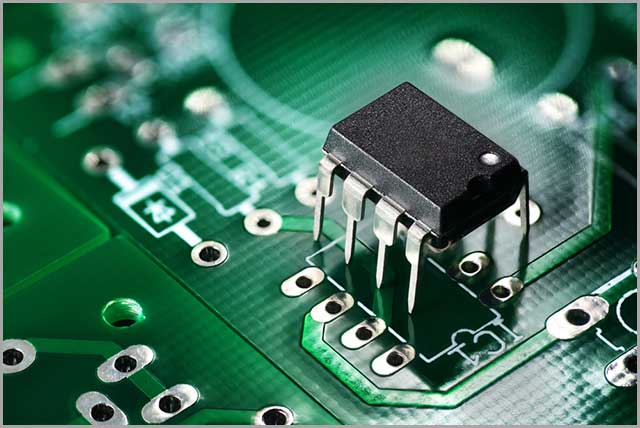
5.2Surface Mount Technology (SMT) assembly process
Step 1: Solder paste printing – This process involves applying solder paste directly onto a printed circuit board. You achieve this by writing solder paste using stencil apertures.
Step 2: Component installation—Printed circuit boards (PCBs) consist of several components, including capacitors, diodes, fuses, and resistors.
Component placement is installing all the parts that make up a PCB.
Step 3: Reflow soldering –This is a process whereby you temporarily use solder paste to attach hundreds or even thousands of PCB components aboard.
After the attachment of the parts, the entire board gets subjected to controlled heat.
Step 4: Wave soldering procedure—This comprises an extensive soldering process in which electronic components are soldered on a printed circuit board to form an electronic assembly.
Again, the name comes from using molten solder to attach metal components to the printed circuit board.
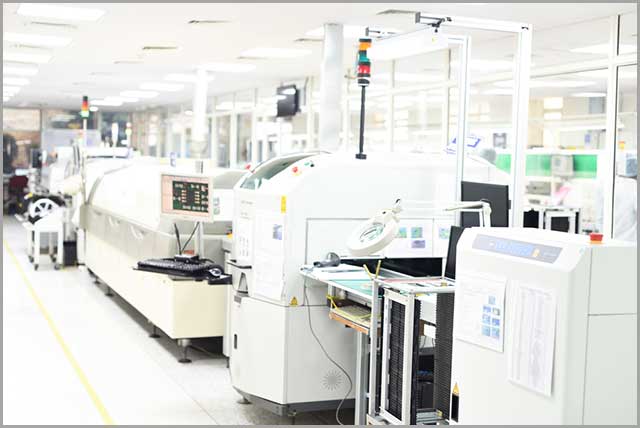
5.3 Hybrid technology
A hybrid integrated circuit is a miniaturized electronic circuit made of individual devices such as transistors, resistors, and capacitors bonded to a substrate or a printed circuit board.
Hybrid technology assembly comprises the following:
Single-sided mixed assembly: In this type, through-holes and SMDs get mounted, but only on one side of the PCB.
Double-sided mixed assembly: In double-sided diverse construction, SMDs are mounted on both sides of the PCB.
5.4 How to choose the right PCB assembly technology
To ensure that you are on safe hands, you may want to partner with an experienced firm that has been in business for long.
Additionally, you need to follow an appropriate timeline, not forgetting to evaluate your potential partner’s quality.
Also, check on issues such as customer support, costs of manufacture, and other red flags such as long unresponsiveness timelines and lack of references.
PCB Assembly Process-welding
When it comes to wave soldering, melted solder is transformed into the required solder wave through an electromagnetic bump or mechanical bump with jet flow.
6.1 Basic welding
Welding is the process of placing one or more electronic components on a printed circuit board using solder.
PCB welding is the same as PCB soldering, which is divided into fusion welding, pressure welding, and brazing.
Infusion welding involves applying heat in the form of an electric arc. Pressure welding involves joining components by applying temperature and pressure.
Lastly, brazing welding involves using a brass filler rod coated with flux to join parts of a PCB.
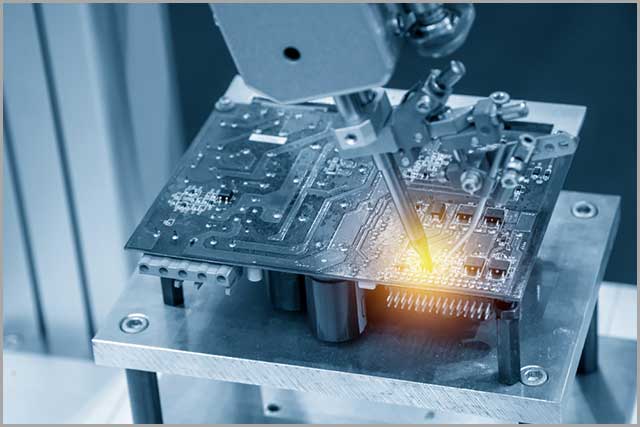
6.2 Solder
Solder is a low-melting alloy mainly used to create permanent bonds between metal workpieces. After cooling, the solder is melted to adhere to and connect parts.
6.3 Welding equipment
Welding equipment used by engineers assists in creating a joint on a given workpiece. Soldering equipment includes stick welders, soldering irons, MIG welders, TIG welders, filler metals, electrodes, and torches.
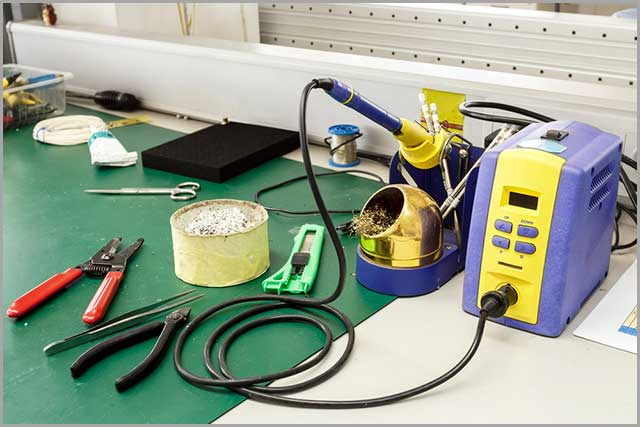
PCB Assembly
A printed circuit board with components mounted on it is an assembled printed circuit board. The manufacturing process is known as PCBA or printed circuit board assembly.
7.1 Cost structure
• Labor cost—Of course, labor prices will impact the overall cost of the PCB. The amount of money paid to the workforce will determine the PCB’s value.
• Turnaround time—how fast you want your PCBs delivered will also impact their prices. The manufacturing firm may prioritize your orders first, which will increase costs.
• Quantity—How many PCBs do you want? If you want a large number, you must be prepared for huge costs.
• Technology—The technology used in the manufacture of PCBs will impact their costs. If you prefer the use of the latest technology, you’ll pay a little extra.
• Material selection – the type of material you may want on your boards, especially fire-resistant materials, may cost you more. It’s that simple. Some of the best stuff out there will cost you more.
• Quantity ordered—if you order more, you’ll have to pay more. Supply will impact the cost.
7.2 How to reduce the cost of PCB assembly
If you want to reduce the costs of PCB assembly, there are several steps you must take. First, you must ensure you deliver complete Bills of Material to your manufacturer.
Secondly, ensure that you take advantage of your manufacturers’ sourcing services. Thirdly, don’t skimp on matters to do with inspection.
Fourth and last, ensure that you optimize your bare board schematics.
Prepare Printed Circuit Board Assembly Documents.
Precise assembly drawing
Before you manufacture a PCB, it’s essential to have a transparent assembly drawing that will accompany the design process. As a PCB designer, you must know everything necessary for the drawing, such as the drilling size and special processing requirements.
Questions in the bill of materials
Gerber File
This is a file format that PCB designers use to get their design data. They contain information about every PCB layer that assemblers use during PCBA.
Gerber files translate all the details of the PCB to the physical components of the PCB.
Supplier list
PCB designers will want to improve their approved vendor list when preparing materials and electronic equipment schematics bills.
Improving the supply base is essential to ensure you are partnering with the right suppliers.
Make sure to understand PCB documentation standard
To ensure that your PCBs are of the right quality throughout, it’s vital to ensure that you have a good understanding of PCB documentation standards.
Adhering to IPC rules for assembling electronic equipment is one way to achieve this. With IPC standards, you can be assured of producing high-performing PCBs.
Files you usually forget
As a PCB assembler, you’ll have plenty of data to use. Unfortunately, as a human being, there are some files that you may forget.
To ensure that you avoid such, you have to create a particular folder containing essential data. For ease of access, make sure that you save such files using an available name and probably on your PC’s desktop.
Features of high-quality files
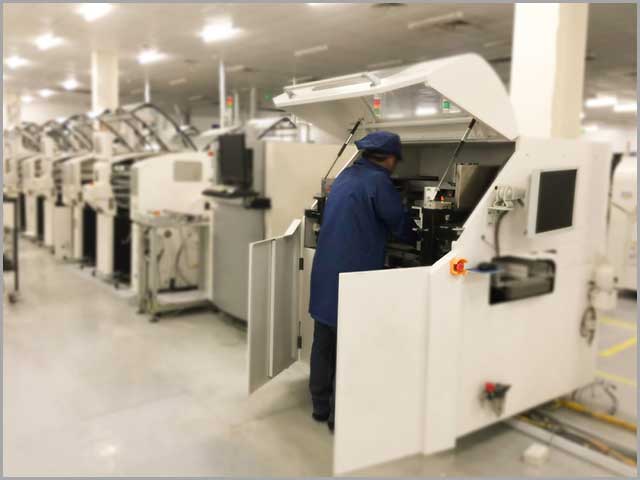
Common Problems of the Printed Circuit Board Assembly
PCBs make electronic devices that we use daily to function as intended. Therefore, when some parts malfunction on a PCB, there is are high chance that the electronic device that relies on the PCB won’t work correctly.
The following are some of the most common problems concerning PCBA.
1. Problems that should be paid attention to between traditional PCB assembly and modern PCB assembly
Things have changed recently, especially regarding printed circuit board assembly. Thanks to technology, assemblers now employ several techniques and tools to ensure that PCB assembly is fast and precise.
To find the best boards, you may have to partner with manufacturers that adhere to the latest PCB design issues, such as SMT technology, wave soldering, through-hole soldering, and DFM, to mention but a few.
2. LED problems during PCB assembly
This issue is another problem that engineers face during PCB assembly. LED points manifest through short circuits, LED lights going off, and cases involving open courses.
You’ll get the smell of something burning or the LED light going off without warning.
3. Too small/too large copper edges
When the copper edges of a printed circuit board are either too small or too large, it may affect its overall functionality.
The minimum recommended size for outer layers is 0.010 inches. The preferred format for inner layers is 0.020 inches.
4. Solder joint defects
As a PCB manufacturer, solder joint abnormalities are something you’d want to avoid at all times.
Common errors may occur due to overheated joints, cold joints, welding balling, or excessive solder use.
Also, insufficient wetting, solder skips, and solder splashes could bring about weld joint defects.
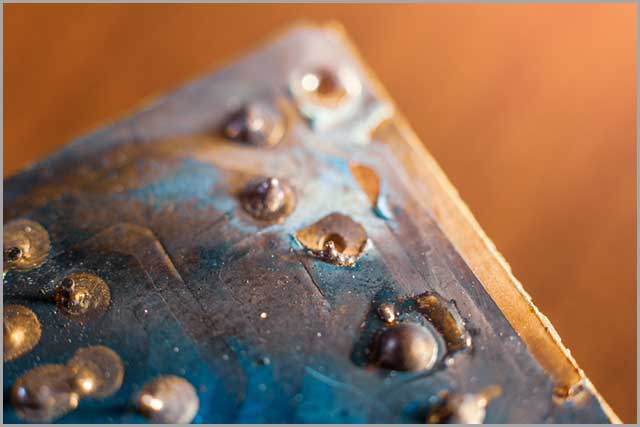
5. PCB assembly of small parts
The assembly of small PCB parts is a problem that many designers strive to solve. The main challenge arises, especially when a manufacturer lacks special SMT equipment.
Manual placement of such small parts may produce boards that won’t function as intended.
6. Problems with the dispensing method
PCB dispensing involves transferring adhesive onto the printed circuit board solder mask.
Dispensing ensures that all the components stay in place until the PCB gets wave-soldered. Choosing the wrong dispensing method is another PCBA problem.
Robotic distributing is one of the best-dispensing ways that you can use.
7. Assembly of regular and irregular patches
A PCB consists of regular and uneven pieces. Some parts have to fit together, while others must stand independently.
Unfortunately, when it comes to assembling PCBs, many producers fail to assemble irregular pieces. This often requires specialized machines and expertise, which many firms lack.
8. Material adhesion problems during PCB assembly
Adhesion is the process of matching different types of materials to one another. High-quality adhesives are necessary during PCB assembly.
The reason is that the materials are of high quality and promise proper PCB functionality.
9. The PCB assembly process solves the heat dissipation problem
When it comes to PCBA, heat management is essential. A printed circuit board whose design cannot dissipate heat effectively will see the production of equipment that won’t operate properly.
Boards that can’t dissipate heat are bound to fail in the end.
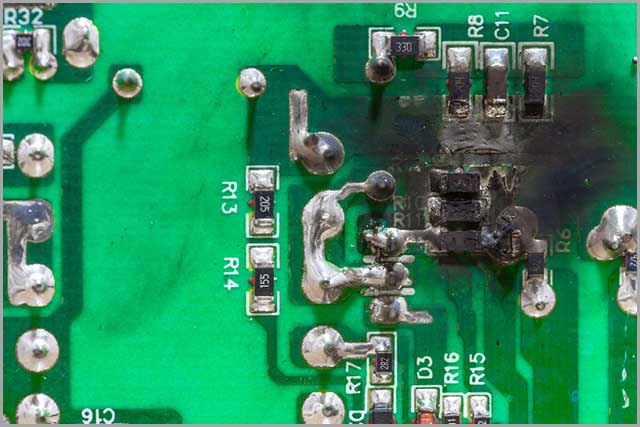
10. Design for Manufacturing (DFM)
Also known as DFM, design for manufacturing is an engineering practice that PCB designers use to create easy-to-use products. DFM examines the design of a product based on its functionality, tolerances, and materials.
Before purchasing PCBs, you need to ensure that the producers have DFM considerations at the back of their minds.
PCB Assembly Service
A printed circuit board populated with electronic parts is a printed circuit board assembly (PCBA). In free use, PCBA commonly stands for “printed circuit assembly” consisting of components.
• PCB assembly characteristics
PCB assembly involves the entire process of connecting electronic components with the wirings of a PCB. Here, there’s the use of specialized equipment and tools required to achieve this.
• Parts procurement
A PCB is made of several components such as diodes, anodes, solder mask, and wires, to mention but a few. Parts procurement is necessary for PCBA. P
arts procurement includes the identification of a need, the negotiation of a contract, vetting, and the selection of the best vendor.
• Service
This involves selecting the best PCBA services. There are plenty of PCBA service providers, but not all of them are good at their work. Service selection involves picking the best in the field.
• Overview of assembly capabilities
To ensure that your electronic components function correctly, you may have to source or use PCBs manufactured by firms with impressive assembly capabilities.
Is the firm of your choice able to do conformal coating and potting?
What about knowledge of PTH technology? Ensure you have a firm equipped with automated solder paste application, automatic optical inspection, and SMT reflow or wave soldering.
• Assembly equipment
The type of assembly equipment matters a lot. Standard or substandard assembly equipment may see you producing PCBs that aren’t fit for the market. As a manufacturer, you must use state-of-the-art equipment that produces high-quality PCBs.
• Quality Assurance
As a printed circuit board assembler, you need to ensure that your products maintain the desired quality level. You can achieve this by paying particular attention to every stage of the manufacturing process.
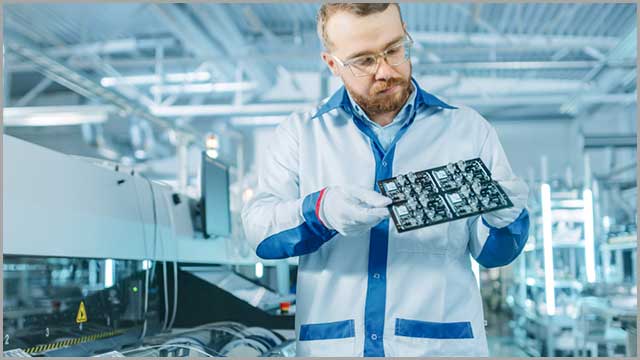
Summary
Your printed circuit boards will function properly in your electrical components if you understand all the above aspects. Your printed contact us.
We have a professional PCB production factory here; if you are interested, you can visit it. I hope this article is helpful to you.





